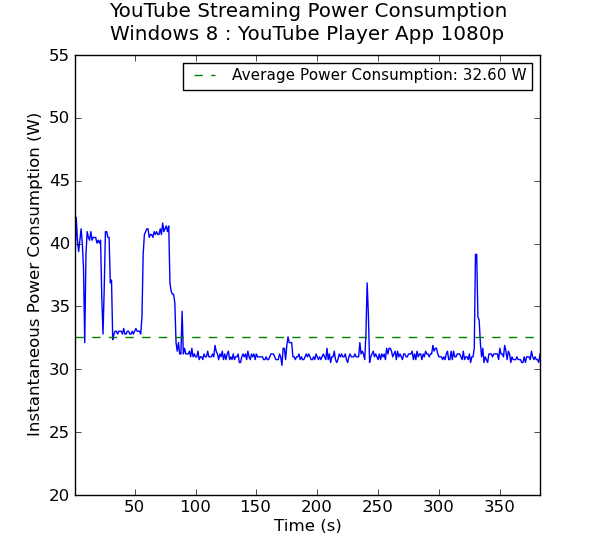Getting the Best out of an Ivy Bridge HTPC: Windows 8, madVR and More..
by Ganesh T S on January 20, 2013 3:00 PM EST- Posted in
- Home Theater
- Intel
- HTPC
- Ivy Bridge
- Windows 8
- Passive Cooling
Network Streaming Performance - YouTube
YouTube is one of the most popular video streaming services, and Google maintains a number of encodes for each stream. On platforms supporting Adobe Flash, FLV streams are available at resolutions ranging from 240p to 480p. HTML5 streams are either in WebM (for Firefox) or MP4 / H.264 (for Internet Explorer). WebM streams typically top out at 720p, while MP4 is the preferred format for 1080p. At higher resolutions, Adobe Flash also streams the MP4 version.
As expected, we get GPU acceleration when using Adobe Flash in Firefox on Windows 7. The debug OSD presents the requisite details.
HD YouTube Streaming using Adobe Flash in Mozilla Firefox on Windows 7
Windows 8 has an app for YouTube, 'YouTube Player' which allows for stream quality selection. Just like the Netflix app, there is no direct way to determine if GPU acceleration is being used.
HD YouTube Streaming using the YouTube Player App on Windows 8
We will rely on the power consumption at the wall to determine the efficiency of various ways to stream YouTube videos across different operating systems. Since the matrix of options is quite big, we present the graphs one at a time. All the graphs are on the same scale. Press the button below corresponding to the combination you want to compare the current graph against.

It can be seen that the Windows 8 YouTube Player App wins hands down. The stream being decoded is, in all probability, the 1080p H.264 version. Even when Adobe Flash is being used, Windows 8 seems to be more efficient compared to Windows 7. If you are on Windows, and prefer to use HTML5, it is better to avoid Mozilla Firefox because the WebM version consumes the most power at the wall (due to lack of hardware accelerated decode) while providing only a 720p stream. Once again, if YouTube forms a major part of your HTPC experience, an upgrade from Windows 7 to Windows 8 can be recommended.












138 Comments
View All Comments
zlandar - Sunday, January 20, 2013 - link
This is a ridiculous amount of hardware to play Blu-Ray and stream Youtube and Netflix. The Core2Duo system posted by another Anandtech writer would be more than adequate to handle any of the listed activities:http://www.anandtech.com/show/6670/dragging-core2d...
"I would strongly suggest HTPC users relying on WMC (irrespective of the OS) to move on to other platforms."
As other posters have already remarked how the hell are you supposed to watch cable programming through a Ceton or Prime using a Cablecard without WMC? What other "alternatives" support tuners utilizing a cablecard to watch encrypted programming?
I suggest you actually list activities that require a HTPC. Like watching and recording shows through a TV tuner. Different types of storage options for handling all the HD recorded shows. How your build can handle commercial skipping of recorded programming.
ganeshts - Sunday, January 20, 2013 - link
Different people have different definitions for HTPCs.At the minimum, a HTPC should be able to play back videos in different codecs in a power efficient manner and should have a good network connection (both to the Internet and to the local network). Beyond this, people might want to use CableCard tuners (in the US) or OTA tuners (elsewhere and also in the US). But, these are strictly optional.
Sometimes, users might have a cable TV connection and feel there is nothing wrong in sourcing content off questionable sources online. From content provider / the cable company's viewpoint, there is no monetary loss when people do that or actually record shows and do commercial skipping (but, for the law, that is not quite right). This is a tangential discussion.
I also strongly suggest people who ask me for HTPC building advice to do their TV show recording / place Internet downloads on a NAS rather than one of the HTPC drives itself. Personally, I have seen quite a few setups where a iSCSI drive is mapped for 'local storage' on a HTPC.
Booty - Monday, January 21, 2013 - link
Ethics of grabbing TV rips from "questionable sources" aside, there are shows that just flat-out aren't available... I DVR a variety of such shows, from DIY stuff on HGTV to live music on Palladia. I need CableCard support. If all I wanted was to stream online content I'd get a Roku or Boxee box.Also - you complain about WMC being a $10 add-on in Windows 8, yet suggest a $50 piece of software (JRiver) as a potential replacement?
Finally - network storage is not for everyone. Personally, I have a file server... but I have built HTPCs for a number of friends and relatives, and for them it's not a practical solution.
I was excited to see a new HTPC related article posted... and am extremely disappointed with the content. Sorry, but reading the article was a complete waste of my time.
cjs150 - Monday, January 21, 2013 - link
I agree totally with ganeshts but can understand why some people do not see the point of an HTPC.I have built an HTPC recently which I use most days. It had to look part of my AV equipment (most streamers do not), I have a large collection of movies on a NAS (which is a total pain to work with W8 - allegedly this is a design security feature as opposed to MS not understanding how people work), I use Lovefilm regularly (Netflixs has not got a big enough same library in UK) even though the streaming is inconsistent (and I have a very fast braodband) particularly for HD films.
I have moved to W8 Pro and WMC (but with My Movies add on). W8 makes more sense than w7 on an HTPC as the UI works well from the Sofa. But WMC is a tired application whose only advantages are that it is (a) free until 31 Jan (b) has an EPG and therefore does well for TV recording (but I use the cable st top box for that) (c) if I stick a blu ray into the optical drive PowerDVD will play within WMC.
I would like to move to XBMC but... (a) TV front end is not mature and has no UK EPG (b) working with files on a NAS is even more painful than W8 (c) with my luck I would no doubt find that all the movies will filed in the wrong format for XBMC! (d) XBMC cannot play blu-rays natively and there is no program (yet) which links seamlessly to XBMC to handle that.
cjb110 - Monday, January 21, 2013 - link
I was running XBMC on my Win7/Fusion and I'm just trialling the OpenElec distro (very nice so far).90% of my content is on my Infrant ReadyNas, only BluRay/HDDVD rips are local. I've had no issues with XBMC and this setup, just add the source and tell it the type.
I think XBMC prefers the Movies\Movie Name [Year] structure over everything else, but it seems to be fairly flexible.
I'm also using meta<browser> to auto-sort the TV shows and manage the metadata for everything.
I think the latest Frodo release improves the blu-ray compatibility a bit, supports HD Audio at least, but agreed its not there yet. Though using Windows its fairly easy to setup XBMC to use a third-party blu-ray software.
zilexa - Monday, January 21, 2013 - link
@cjs150, XBMC works perfectly with NAS, and has no file format issues.. actually most active forum visitors use it like this. Works flawlessly. Also with the latest XBMC release the TV frontend is mature. No idea if it works for your specific need in the UK. And with the new version, there is native bluray support.. although I never missed it.. prefer to download to good rip instead of working with optical discs. Unfortunately its impossible to buy hq bluray rips......babgvant - Monday, January 21, 2013 - link
I don't agree with the point around recording to a NAS device. It can work, but I wouldn't recommend it to anyone who isn't intimately familiar with designing a solid network and server infrastructure. Unless your NAS has a good CPU and NIC (most don't) this is an invitation for problems. You'd be surprised by how many HTPC can't even using muti-tuner network setups reliably (i.e. anything with Realtek integrated NICs).Obviously there are benefits (less noise & heat in the HTPC), but you take on risk by adding additional points of failure to the system. Also, if you're doing anything interesting with the files (e.g. commercial scanning) the NIC takes a lot of unnecessary load shuttling significant amounts of data around - only aggravated by the use of network tuners.
zilexa - Monday, January 21, 2013 - link
thats a very specific need, 1 type of card necessary to watch specific content.. never even heard about it. With tv subscriptions available via DVB-T, DVB-C, DVB-S and now much, much more popular IPTV (unfortunately encrypted by all providers except 1), it's impossible to interpret generic recommendations from a reviewer for very specific needs..I lost the need to use a tv tuner since the necessary dvb hardware is too expensive, not much options and way to difficult to setup. Since tv broadcasts really suck in my country.. I dont need to record it or anything. XBMC fulflls all needs and the tiny IPTV box from my provider is more then sufficient for the rest. But thats just my specific situation ;)
nevcairiel - Monday, January 21, 2013 - link
"This is because there is currently no support in the open source native DXVA2 decoders for interlaced VC-1, and hence, it is done in software."This is wrong. LAV Video supports DXVA2 of interlaced VC-1 just fine - just not on Intel.
The problem here is Intel. They don't support the "standard" VC-1 DXVA as specified by Microsoft, and instead use a proprietary interface, which they don't document, and only expose through the Media SDK (which the QuickSync decoder uses)
This is also not limited to interlaced, but all VC-1
nevcairiel - Monday, January 21, 2013 - link
And while i'm on the topic of DXVA:madVR supports Native DXVA2 in recent versions now.